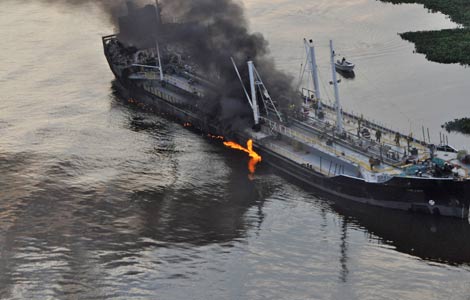Agency defends giving railway ministry rating
Updated: 2011-08-15 07:10
(China Daily)
|
|||||||||||
Sufficient cash flow and 'strong' ability to repay reasons for AAA
BEIJING - Rating agency Dagong Global Credit Rating Co defended the AAA rating it gave the Ministry of Railways on Saturday, despite severe public criticism of the ministry following a fatal train crash last month.
The ministry received the long-term rating after launching its first bond sales on Monday since the crash on July 23 that killed 40 people near Wenzhou city in East China's Zhejiang province.
The rating was assigned because of the ministry's status as a government agency and it is backed by government revenue, Dagong said in an e-mail to Xinhua News Agency.
Other reasons for granting the rating include the ministry's sufficient capital flow, Dagong said.
The agency explained its reasoning in response to questions over the heavily indebted ministry. There has also been mounting skepticism, since the accident, over the ministry's credibility and the actual safety of the fast-expanding rail network.
The AAA rating given to the ministry is even a notch above China's currency debt rating of AA+, also rated by Dagong.
Government data showed the ministry's debts exceeded 2 trillion yuan ($313 billion) at the end of June, raising its debt ratio to 58.53 percent, slightly up from the end of the first quarter of this year.
Dagong said in the statement that the debt-to-asset ratio is at a level considered medium, much lower than the alert line for the ministry, which is 75 percent.
The ministry has large-scale valuable assets and relatively large room for fund-raising, Dagong said.
The ministry has an "extremely strong" ability to repay as it is backed by State credit, Dagong said. It is one of just three government departments that can issue bonds, the other two are the Ministry of Finance and the People's Bank of China.
The ministry's bond sales saw it put 20 billion yuan worth of three-month bills on offer in the interbank market, with a yield of 5.55 percent, a relatively high rate for short-term government paper.
Before the crash in July, the ministry issued 20 billion yuan of one-year commercial papers with a coupon rate of 5.18 percent, but only 18.73 billion yuan of the total was bought.
Analysts said it has become more difficult for the ministry to borrow money because of tightened market liquidity and concerns over the ministry's debt burden.
China's top four banks said at the end of last month that they will continue to offer loans to the ministry based on market conditions and risk appraisal.
Credit from the four largest State-owned banks, including the Industrial and Commercial Bank of China and the Construction Bank of China, has been the major source of funding for the construction of China's expanding railways in recent years.
Operational cash flow has continued to grow, making the ministry invulnerable to default risks due to management problems, the statement added.
Safety concerns following the accident prompted the State Council on Wednesday to order bullet trains to run at slower speeds and ticket prices were reduced.
Dagong said that the losses from the accident are not of a large enough scale to hurt the ministry's ability to repay its debt.
"Cheaper tickets will attract more passengers, which will offset the losses from lower prices," it said, adding that slower speeds will reduce maintenance costs.
In addition, Dagong said China will continue to ramp up investment in railway construction, and this will improve the ministry's financial standing in the future.
The State Council on Wednesday reiterated its determination to improve the rail network.
"China will unswervingly continue its development of high-speed railways," it said.
The ministry's spokesman Wang Yongping said in May that the ministry's total investment this year will reach 745.5 billion yuan, with 600 billion yuan going on infrastructure.
China plans to invest 2.8 trillion yuan in the railway sector in the 2011-2015 period during which the length of its high-speed railways are expected to expand to 45,000 km.
Related Stories
China to start safety checks on high-speed rail 2011-08-12 22:51
Chinese train maker recalls 54 high-speed trains 2011-08-12 13:54
China orders safety checks on high-speed rails 2011-08-11 10:58
High-speed train manufacturer suspends delivery 2011-08-11 06:47
Hot Topics
Anti-Gay, Giant Panda, Subway, High Speed Train, Coal Mine, High Temperature, Rainstorm, Sino-US, Oil Spill, Zhu Min
Editor's Picks

|

|

|

|

|

|







